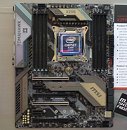Tuesday, May 30th 2017

MSI X299 Gaming Pro Carbon, Gaming M7, SLI Plus, and Tomahawk Pictured
MSI showed off three of its premium-segment socket LGA2066 motherboards, the X299 Gaming Pro Carbon, X299 Gaming M7, X299 SLI Plus, and X299 Tomahawk. All four boards are based on a common PCB, with subtle variations to the designs of the PCH/VRM heatsinks, I/O shroud, and PCB paintjobs, besides some included accessories. Kudos to MSI engineers for minimizing R&D costs, let's just hope that these boards are priced within 10 percent of each other.
The board draws power from 24-pin ATX, 8-pin EPS, and 4-pin ATX (on some of the higher-end models). A 9-phase VRM conditions power for the CPU. Eight DDR4 DIMM slots, and four PCI-Express 3.0 x16 slots are wired to the CPU. Three 32 Gb/s M.2 and one 32 Gb/s U.2 are common across all boards. Also common here is the Audio Boost IV onboard audio solution, with a 120 dBA SNR CODEC, audio-grade capacitors, and OPAMP. Some of the models feature just the one GbE interface driven by i219-V controller, some feature two; and some of the higher-end models such as the Gaming M7 and Gaming Pro Carbon even feature Killer 802.11ac+BT4.1 WLAN cards. The higher-end boards also feature a bigger spread of RGB LEDs. Pricing-wise, one can expect the X299 SLI Plus to be the cheapest, followed by the X299 Tomahawk, X299 Gaming Pro Carbon, and the X299 Gaming M7. We wonder why.
The board draws power from 24-pin ATX, 8-pin EPS, and 4-pin ATX (on some of the higher-end models). A 9-phase VRM conditions power for the CPU. Eight DDR4 DIMM slots, and four PCI-Express 3.0 x16 slots are wired to the CPU. Three 32 Gb/s M.2 and one 32 Gb/s U.2 are common across all boards. Also common here is the Audio Boost IV onboard audio solution, with a 120 dBA SNR CODEC, audio-grade capacitors, and OPAMP. Some of the models feature just the one GbE interface driven by i219-V controller, some feature two; and some of the higher-end models such as the Gaming M7 and Gaming Pro Carbon even feature Killer 802.11ac+BT4.1 WLAN cards. The higher-end boards also feature a bigger spread of RGB LEDs. Pricing-wise, one can expect the X299 SLI Plus to be the cheapest, followed by the X299 Tomahawk, X299 Gaming Pro Carbon, and the X299 Gaming M7. We wonder why.




4 Comments on MSI X299 Gaming Pro Carbon, Gaming M7, SLI Plus, and Tomahawk Pictured